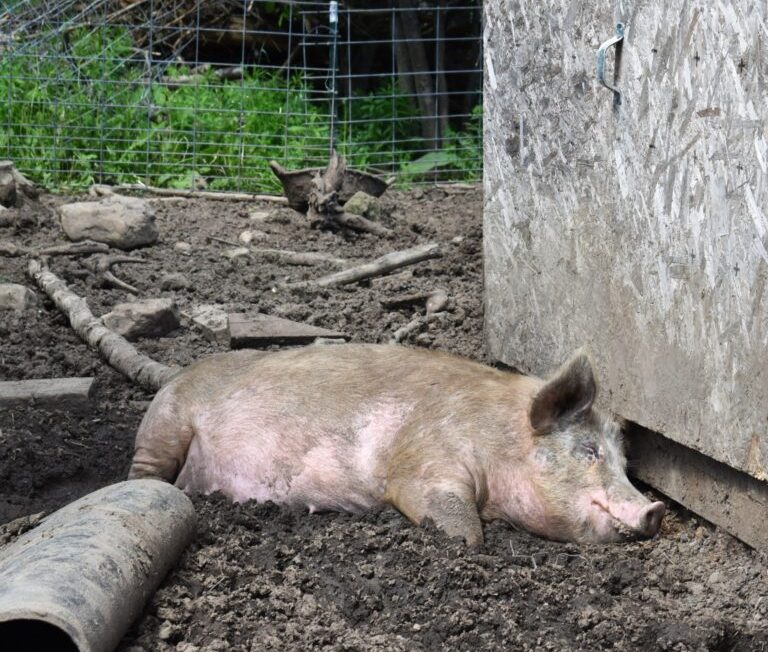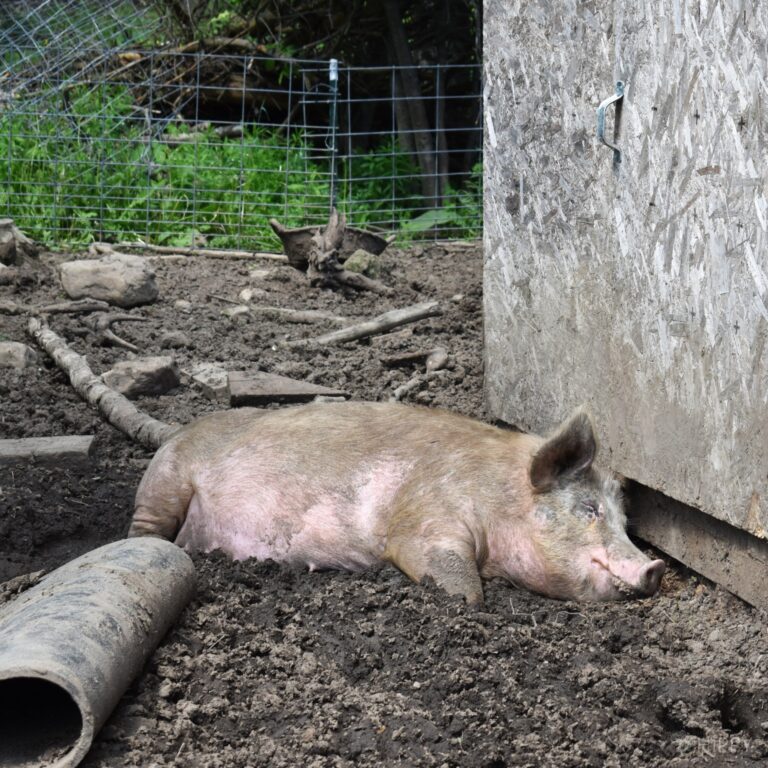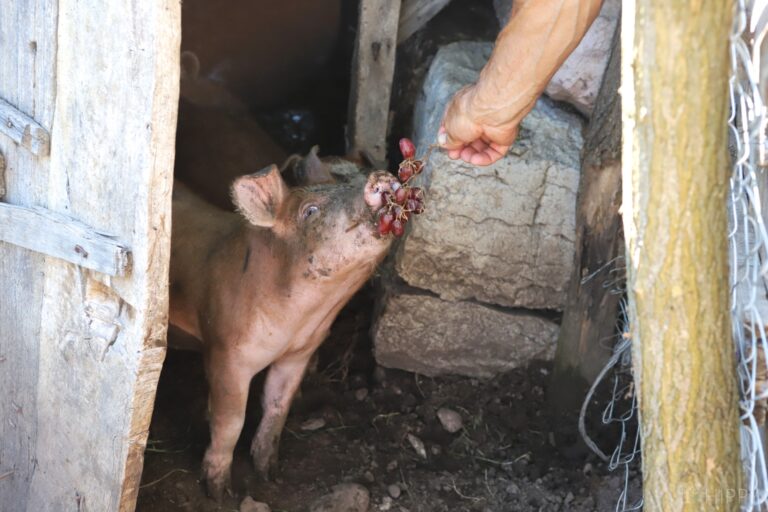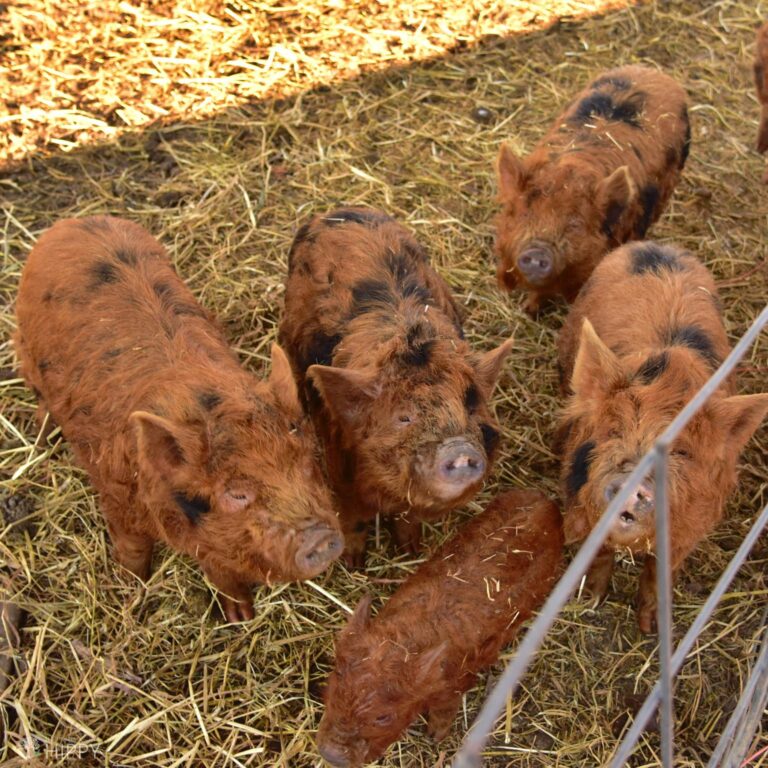Housing and Fencing for Your Pigs: Start Here


Pigs are probably my favorite livestock to keep on the homestead. They grow quickly, have easy dietary requirements, and tend to be quite healthy given even a little bit of care. And, of course, you get all the delicious bacon you want!
I’ve noticed more and more homesteaders taking the plunge with pigs when they are first getting started with livestock on their properties.
But there’s definitely a trick to keeping pigs, namely in keeping them contained and providing them with proper housing.
Pigs are remarkably destructive, and they can easily tear down or slip through fencing that isn’t up to the task. Worse, some people believe that pigs can just stay outside 24/7 with no shelter and that’s just not true.
This is one area where it’s really easy to make a mistake if you’re a beginner. Keep reading, and I’ll tell you everything you need to know about properly fencing in and housing your pigs.
Probably the single biggest and most harmful misconception I hear over and over again concerning pigs is that they don’t need shelter. You can just keep them outside all the time, right?
No, wrong! While it is true that most mature hogs are happy spending their waking and sleeping hours outside, they still have to have shelter.
If you don’t provide your pigs with adequate shelter, their growth performance will go down, they will be more likely to get sick, and they can possibly even die in hot and cold weather alike. I know you don’t want that to happen!
If it’s in the middle of summer, or you live in a particularly hot and arid climate, the very first thing you must do concerning shelter is make sure your herd has shade.
Pigs, surprisingly enough, are quite vulnerable to high temperatures and to intense, direct sunlight. They can’t sweat, and being sheathed in a thick layer of muscle and fat means that their core temperature will skyrocket when it’s hot outside.
The max temperature that most mature pigs can tolerate is just 75° F (23° C); pretty comfortable by human standards! Once the temperature clears 80° F (26° C), most porkers are in genuine danger of heat-related illness. Higher temps are even more dangerous when the humidity is also high.
Pigs get cool in two ways: wallowing in mud and heading for the shade. You can provide shade with trees, nearby buildings, overhead canopies, or anything else. Your pigs simply must be able to reach it and take shelter under it to get relief from the heat.
Another factor to consider is that light-skinned pigs are vulnerable to sunburn. Very vulnerable! This will make them miserable and exacerbate dehydration which can kill…
At the other end of the temperature spectrum, your animals will need a place to hide and stay comfortable when the weather turns cold, wet, and nasty.
A shelter that will keep wind off of them and also keep rain and snow from falling on them is essential no matter where you live.
It doesn’t have to be big and it doesn’t have to be fancy. It doesn’t even have to be particularly nice as long as it’s sturdy and can meet these simple requirements – and, of course, hold all your pigs!
Plan on your pig pen providing at least eight square feet per adult pig. Very large breeds and mature hogs will need closer to 10 square feet per head.

Before we get into the nuts and bolts of picking out a shelter for your herd, stop and consider where you’re going to place it…
For starters, property and workflow allowing, you’ll want to locate it with the opening facing away from the prevailing wind. This will help keep your animals warmer and keep them dry. It will also cut down on windblown dust and other debris getting in.
Also, make sure you place the pen on a patch of land that isn’t prone to flooding or getting a lot of moving surface water.
So what type of shelter is actually adequate for pigs? It turns out almost any kind as long as it can provide cover from wind and rain, has space for each pig and is well-ventilated.
Much of the time, simpler, rudimentary designs work better than sophisticated types which are more prone to damage or harder to repair (not to mention they will cost you extra).
Consider each of the following choices, as they are perfect for the needs of small herds:
This is the typical livestock shelter you’ve probably seen a hundred times before. Usually found with a flat roof and three walls, it’s entirely open on one side
It might not be a great shelter for people, but it works just fine for pigs because they will snuggle together to stay warm when it’s cold outside. As long as the roof will keep rain and snow off of them and it gives them good protection from wind, you’ll be all set.
Easily built using basic framing techniques and lumber or even rough-hewn logs. May or may not have a solid floor.
One of my very favorite pig shelters, A-frames are durable, easy to build, and reasonably portable. The steeply pitched roof will easily shed rain and snow, and you can leave them open on one or both ends. The only trick with an A-frame is to make sure it is large and heavy enough that pigs won’t try to push it over.
A hoop house looks a little bit like a Quonset hut and will usually be built partially from wood closer to the ground with the upper members made from plastic or steel. The roofs are typically made of fabric or plastic tarps, or sometimes metal cladding.
These often strike a great balance between cost and spaciousness, and might be the perfect option depending on what materials you have on hand.
If you are really in need of a shelter for your pigs and are desperately strapped for time, money, resources, or all three, you can construct a hay bale house. It is exactly what it says, basically just a run-in shelter made out of hay bales.
Roofing is usually boards or planks laid across the top with a tarp or corrugated paneling on top of that. If you have time, you can split the walls with posts or rods to prevent pigs from knocking it over. This is a design that’s not made to last, but it can do the job on a temporary basis.
Remember that any shelter you plan on using in the future must be tough, really tough! It has to be resistant to the attention of your pigs.
Pigs are, as mentioned, notoriously destructive, and if you’ve never kept them before, you’re going to learn here really soon. They are strong, stubborn, and heavy, and they’ll start to break down shelters just by leaning on the walls and posts, chewing on things, and slamming into them.
Whatever kind of pen you build, it’s critical that it be strong enough to resist this kind of activity, and any lightweight materials you use must be totally out of reach, or else your pigs will chew them up and swallow them.
In any case, don’t be surprised if you find them chewing on solid wood posts and planking! Repairs will be an ongoing part of your life, so be ready for it.
If you plan on going big with pigs, you’ll need a correspondingly large shelter. This is where a jumbo shed or even a proper barn makes a lot of sense.
This will make it easier to direct and control your pigs, separate or isolate them for various tasks, and keep them safe even when the weather is at its nastiest.
Barn design and setup is a wholly separate subject unto itself, but for now, just be content knowing that this one iisn’t strictly necessary
A special shelter consideration if you plan on expanding your herd the old-fashioned way is the necessity of a farrowing house or pen.
This is a special, dedicated enclosure where you can put a sow and her piglets so they have a quiet, comfortable, and safe environment away from the rest of the herd.
If you have a large shelter like a shed or barn, this can be an isolated enclosure just for mom and her babies.
If your herd is outdoors most of the time, this could be a smaller, separate shelter that the other pigs can’t get into, or even a smaller, separate paddock that has plenty of shade and warm straw for nesting.
A constant question I’m asked about housing pigs is whether or not they need supplemental heat, and the rule of thumb is that they do not, with a couple of clear-cut exceptions…
Newborn piglets and growing weaners are far more vulnerable to cold compared to aduls. As long as they’re in a good shelter and snuggled up with mom and each other on warm bedding, they should be fine.
If the weather is so cold that temperatures inside the farrowing pen are cool or chilly, you’ll definitely need to invest in heat lamps or a livestock-safe space heater.
For piglets that are still suckling, temps in their pen should be right around 85° F, tapering down to around 77° F once they reach 15 pounds, and 70° F once they reach 45 pounds. Once they hit 100 pounds, they can start tolerating much cooler temps for longer periods of time.
Whatever kind of heating solution you use, make sure the temperature is monitored and that all pigs, including mom, can move away from the heat source to cool off a bit if needed.

Shelter is only one half of the battle when it comes to properly housing pigs; fencing is the other half, and by far the more difficult one!
Although they aren’t quite the escape artists that goats are, pigs will readily and repeatedly break out of any fenced enclosure they can push over, break, wiggle through, or dig under.
Because of their natural aptitude for escape, only a few types of fencing are even worth consideration for reliably containing pigs. Any of the following will work as long as they are 3 feet tall or a little taller.
Far and away my favorite fencing option for keeping pigs corralled. The sharp pop of an electric fence won’t really injure pigs as long as it’s set up correctly, but it’ll give them a strong psychological incentive to stay well away from it.
Your two basic options are netting or polywire. Both work, but I greatly prefer multiple strands of polywire to avoid entanglement hazards.
When stringing electric fencing, you must have strands high enough off the ground to prevent pigs from jumping over it – not common, but can happen – and low enough to stop them from belly crawling under it.
Also, keep an eye out for dugout low spots that might let them wriggle under the wire.
You can use solar power or direct current, but just make sure you keep the fence maintained and energized at all times!
Hog panels, sometimes generically referred to as livestock panels, are tough, stiff wire grid fencing sections that get progressively smaller in size closer to the bottom of the panel. This ingenious design prevents piglets from squeezing out, too.
They’re versatile and strong enough to withstand nearly any hog, but they can be expensive and are a pain to move.
The weak point with this fencing is that hogs can dig under it or excavate enough soil around the posts to weaken it and make it prone to pushing over. You’ll need to reinforce posts and try to prevent digging and rooting as much as possible.
This can sometimes be done using a moat of large gravel around the base of the fence, extending 6 to 12 inches on either side, or using buried skirting which the critters can’t dig through.
Chain link is a viable but uncommon option for pig enclosures. It is flexible and certainly strong enough to withstand any attempt at breaking through it, but just like hog panels, the vulnerability is the posts.
Once the posts are weak enough by digging and leaning, pigs can push whole sections right over or get them to droop enough where they can simply walk over them.
If you already have existing chain link fencing, feel free to use it; just don’t skip out when installing the posts.
The following tips and tricks are hard-earned fencing wisdom that I picked up over the years of raising pigs. I either learned them the fun way, by experience, or from my neighbors and mentors who went the hard way before me.
Before you purchase or commit to building a fence to contain your herd, really think through your workflow with them…
Are you going to move them from place to place for whatever reason? If you are, electric fencing needs to be your go-to because it’s extremely portable and quick to set up.
Sinking fence posts into the ground for hog panels or chain link takes a lot of time and effort because it must physically be strong enough to withstand the animals.
Pigs only need to touch electric fencing wire to get a zap and be driven off, so it doesn’t need to be anchored quite as solidly.
Whichever kind of fencing style you are going with, I strongly urge you to double up. This way you’ll have a backup in case one system fails.
My favorite combo is hog panels with a single strand of polywire about 10 inches off the ground on the inside.
If, for whatever reason, the electric fence goes out, the hog panels will keep the critters in until I can re-energize it.
Likewise, if I am working on the hog panels or something knocks them down, hopefully, the poly wire is still intact and the pigs will instinctively stay away from it based on past experience.
Here’s a tip that I only found out about when it was way too late: whether you’re keeping your pigs in a large structure like a barn or outside in a gated enclosure, never run electric fencing across the gate or other opening whereby the pigs enter and exit.
That’s because, in no time at all, your plump pals will learn to fear the electric fencing and they won’t go near it. They will also be mistrustful of any place where the electric fencing was, associating the hard perimeter with pain. You see where this is going…
If you use electric fencing to reinforce a gate or as a temporary gate, it’ll get to the point where you will have a very hard time getting your herd to cross the threshold individually or as a group. This will make your life absolutely miserable, so don’t do it.
On the other hand, or should I say on the other hoof, you must be prepared for your pigs to try, try and try again when it comes to escaping. Yes, this even includes electric fencing.
Pigs are smart, a lot smarter than you think. I don’t know if they can sense it directly or maybe they can sense your nervousness concerning the fence, but it rarely fails that whenever electric fencing is not energized your pigs will get curious about it.
As soon as one of them discovers that the sting is gone, that thin and flimsy wire isn’t going to keep them in.
This is why regular inspection, maintenance, and testing of electric fencing are critical if you want to rely on it. If you just trust that it’s working all the time, it won’t be long at all before you’ve got one or more pigs on the loose.
Like I said, pigs are smart. If there is a weak spot in the fence, a low spot that they can crawl under, or a gap that is just ever so slightly big enough for them to get out, other pigs will imitate them in short order.
Or, and I’ve seen this happen myself live in person, the jailbreaker will teach other pigs how to get out!
The lesson is this: there’s no such thing as a fluke and no such thing as coincidence when your pigs get out. If you notice a pig is out, it is time to inspect the entirety of their enclosure and every section of fencing until the weak spot is found and corrected.
And you can’t half-ass it: a flimsy or temporary repair means your hogs will get out again in no time.
It might seem cruel, but believe me, the sooner you start training your pigs to avoid electric fencing, and to stay away from fencing generally, the easier your life will be and the happier they will be.
I know some folks who avoid using electric fencing until their pigs are grown, but this isn’t necessary.
The painful lessons they learn when they are piglets will stay with them well into adulthood, and in my experience, piglets that have experienced electric fencing are a lot less likely to attempt to charge through it and potentially get tangled up as they grow up.
As I said above, you’d be wise to use a low strand of poly wire, or electrified netting, in conjunction with hog panels or other piglet-proof physical enclosures for maximum security. Once they grow up, you can switch to electric fencing only if you want.
Tim is a farm boy with vast experience on homesteads, and with survival and prepping. He lives a self-reliant lifestyle along with his aging mother in a quiet and very conservative little town in Ohio. He teaches folks about security, prepping and self-sufficiency not just through his witty writing, but also in person.
Find out more about Tim and the rest of the crew here.
